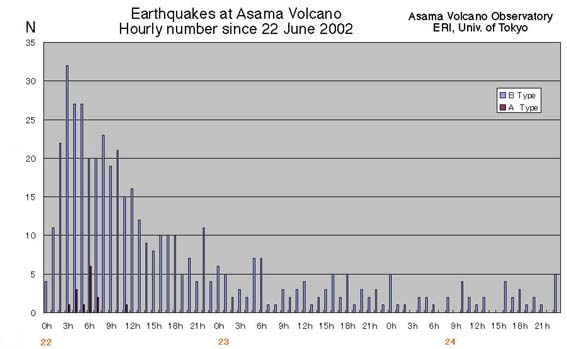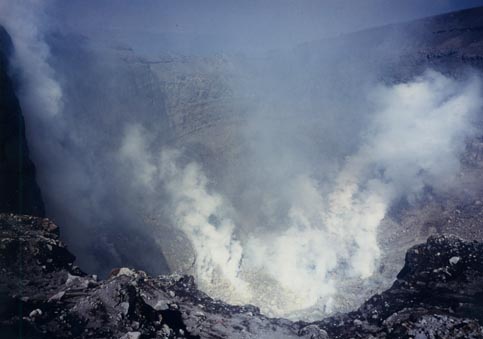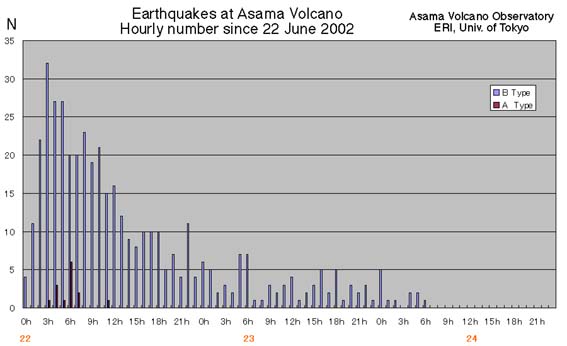
(02/06/2003)
A photographer noticed puffs (two continuous spewing) of discolored smoke from the summit at noon of February 2003, and informed a staff of the Asama Volcano Observatory (ERI-University of Tokyo). He and JMA checked records of seismicity and video footage. A puff of discolored smoke about 300 m above the summit crater was recorded in the JMA videofootage around 12:02. Ash deposition was too small to be visible from the volcano flanks. Deposition of faint ash on snow was confirmed only near the rim of the summit crater from the helicopter of the Nagano Prefecture in the afternoon. JMA issued the Volcano Observation Reports nos. 1 and 2 on Asama volcano on the afternoon of February 6, 2000, stating that puffing of ash was once and the duration was less than several minutes. Asama volcano had been activated in seismicity and smoking activity since last spring and declined since last autumn. Only plume activity had increased since the beginning of February.
According to the seismic record in ERI (University of Tokyo), a tremor related to the puff started about 12:01 and lasted about 40 seconds. The seismicity of this day was in the background level of this volcano during these months and rather small, compared in the previous days. The crater-bottom temperature in night, which has been monitored by the Karuizawa Town, was rather low too.
Information contact: H. Yamasato (JMA): yamasato@met.kishou.go.jp; Volcano Research Center: nakada@eri.u-tokyo.ac.jp
(09/21/2002)
On 19 September, the Asama Volcano Observatory (ERI, Univ. Tokyo) reported a new event of high seismic activity in the volcano that had started around 6:20 a.m., 18 September, 2002. The content of the activity is similar to those of the latest seismic events, where B-type quakes are dominated and A-type ones are intercalated. No N-type was observed. Hypocenters of the quakes locate in the usual places. Relatively large amount of volcanic gas is trailed from the summit.
JMA issued the Volcano Observation Report nos. 7 and 8 on Asama volcano on 19 and 20 September 2002, related to the elevated earthquake activity. Asama volcano had been relatively active since September 2000, a seismic crisis occurred in June 2002, when the daily number of volcanic quakes reached 360, and the daily number had ranged 30 to 50 since then. The seismicity increased after 8 a.m., 18 September, such that 243 times of volcanic earthquakes took place on 18 September, and 128 times on 19 September. The activity had been lowered in the afternoon of 19 September. However, the temperature of the crater bottom had still been high since May 2002. Any change was not observed in ground deformation.
Information contact: Hidefumi Watanabe, volcano Research Center, ERI, Univ. Tokyo, watanabe@eri.u-tokyo.ac.jp; Tomoyuki Kanno, JMA-tokyo, tkanno@met.kishou.go.jp
(06/27/2002)


(06/24/2002)
Seismic activity had decreased since the June 22 morning, but still been high in level, compared with the condition before this time seismic crisis. See blow.

JMA issued Volcano Observation Report No.4 on Asama volcano in the June 24 afternoon, which reports neither volcanic tremor events nor notable change in ground deformation.
Information contact: Tsuneomi Kagiyama, Earthquake Research Institute, University of Tokyo; kagiyama@eri.u-tokyo.ac.jp
(06/22/2002)
The seismic activity at Asama volcano had been in a high level since 1 a.m on June 22, 2002 (JST). Japan Meteorological Agency (JMA) issued Volcanic Advisory #1 on this volcano at 9 a.m. JMA reported total of 210 times of volcanic earthquakes occurred from 1 a.m. to 8 a.m. this morning. The temperature of crater floor had increased since early May 2002, such that about 180 degrees C was recorded on June 19. The height of plume had been over 700 m above the summit, and 1,000 m-height was recorded on June 2 and 4.
According to the Asama Volcano Observatory (ERI, University of Tokyo), the number of B-type earthquakes was peaked at about 3 a.m. of June 22 (more than 30 times per hour at the station on the middle of the eastern slope of Asama), and several A-type earthquakes (M=2.1 as maximum) also occurred during 3 to 7 a.m. The B- and A-type earthquakes were rooted at 1.5 and 3.5 km below the summit.
The City of Komoro and Karuizawa town where Asama volcano locates forbade entrance into the area within 4 km from the summit on June 22, following the limitation of 2 km two days ago.
Information contact: Tomoyuki Kanno, JMA; tkanno@met.kishou.go.jp; Hidefumi Watanabe, Volcano Research Center, ERI-Univ. of Tokyo; watanabe@eri.u-tokyo
The high seismic activity similar to June 22 was observed in September 2000. Swarms of volcanic earthquakes had occurred at Asama every four and five years. The last highest seismic activity was associated with the eruption of 1973 when three events of small-scale pyroclastic flow were observed. Small ash emission occurred when seismic activity was high in 1982 and 1990.
Live camera of Asama Volcano (in Japanese explanation)
Asama-yama today (NTT East Japan)
Mt. Asama Live (NTT East Japan)
Return to menu